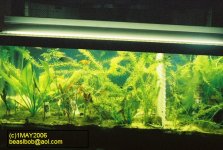A
Anonymous
Guest
Just an update on cal's tank.
Last november Cal lost almost all fish when he visited here, turned down the room heat and relied on the tank heater.
Last December we added a partition to form the left side as the blue dolphin side and the right side as the non blue dolphin side. And I added some anacharous plus another 3' 6500k NO tube. Prior to that only one tube was in use.
When we visited 29apr2006, the anacharous had really taken off. And there is now some moss on the right. So it appears the plants are doing much better. I also bought about 4-6 guppies from my 10g. And added 8 long fin yellow danios.
Still no water changes but he is using a pur filter on the faucet. But that should be changed every 3 months and is now over a year old.
He still has not touched the inside of the glass since the first pictures on this thread in November 2004. He is extremly happy with the ease of maintenance of this setup.
Last november Cal lost almost all fish when he visited here, turned down the room heat and relied on the tank heater.
Last December we added a partition to form the left side as the blue dolphin side and the right side as the non blue dolphin side. And I added some anacharous plus another 3' 6500k NO tube. Prior to that only one tube was in use.
When we visited 29apr2006, the anacharous had really taken off. And there is now some moss on the right. So it appears the plants are doing much better. I also bought about 4-6 guppies from my 10g. And added 8 long fin yellow danios.
Still no water changes but he is using a pur filter on the faucet. But that should be changed every 3 months and is now over a year old.
He still has not touched the inside of the glass since the first pictures on this thread in November 2004. He is extremly happy with the ease of maintenance of this setup.






